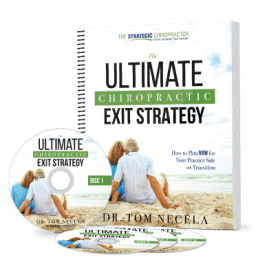For most chiropractors, there comes a point in their chiropractic career that they ask the question: should I buy a chiropractic practice or should I build one from the ground up?
Bad Ways to Buy OR Build
While there is no “right” answer to the above question, there are some universally bad factors that can influence your decision, so let’s get them out of the way first:
- The Bitter Beginning: unfortunately, many chiropractic practice sales and startups begin with the often emotional end of an Associateship gone wrong. While we can’t ignore that fact, the decision to buy a chiropractic practice and enter into your next practice mode should not be an emotional decision. Get objective counsel, seriously weigh your options and do it with a level head. A few months down the road, your irritation about your associateship will likely fade; but your loans to buy or build won’t. So, enter into your new relationship leaving the old one fully behind and moving forward with a clear head.
- No Margin: whether you start a business from scratch or decide to buy a chiropractic practice, be sure to leave yourself enough financial margin to get moving. Historically, a large percentage of small businesses fail because they are under-funded. Don’t be one of them. While it takes a good amount of confidence to enable you to take the leap, it’s a healthy dose of caution that takes a parachute with you so that if the winds blow your business unexpectedly into bad times, you don’t come crashing down.
- Blind and Naked: admittedly, most chiropractors quickly discover that their education contained a big blind spot in the way of business skills. Few DC’s graduate with enough billing, coding and business savvy to navigate the “real world” chiropractic marketplace with a significant measure of success. Worse, some chiropractors go in both blind (in regards to business skills) AND naked (without someone else to help them through it). That may mean you have to invest in skilled staff, a chiropractic coach or seminars to help you overcome this – but, believe me, walking around blind and naked is an easy way to get hurt. So regardless of whether you are looking to buy a chiropractic practice or build one, get help.
The Numbers: Start Up Vs Buying a Chiropractic Practice
Let me first say that this is not a numbers only decision, but few chiropractors do enough math to see the reality of these choices and, as a result, create a situation that statistically is set to fail. Instead, let’s look at the numbers in two hypothetical situations and see what they often say:
Buying a Chiropractic Practice
Let’s me show an example from one of our recent practice sales that can serve as a common scenario that worked out well. A chiropractor purchases a solid, existing chiropractic practice for $350,000 that is currently collecting $500,000 per year with a strong, active patient base. Like many established practices, the overhead is approximately 50% which creates a net to the owner of $250,000 per year.
Like many sales, the Buyer was afraid that patients would leave after the sale and that would cause a cash flow crunch for the business. To prevent patient attrition, we arranged for the Seller to stay on for an “extended” transition and work together with the Buyer for 90 days after the sale. We also created a clear plan for the Buyer and Seller to follow to make sure the transition went well and the Buyer engaged in some inexpensive internal marketing to reactivate patients.
Over the first 90 days, patient visits actually INCREASED from the Seller’s average visits by approximately 22% as patients came in to say goodbye to the exiting doctor and meet the new owner. We attributed this to a solid transition plan. During the next 90 days, the new owner focused on internal marketing and reactivations of patients who had not been in the practice a while. The patient visits increased again approximately 14% from the Seller’s former average — and the Seller was no longer present in the practice. During the next 90 days (so this was now more than 6 months after the sale), the new Owner continued with the reactivation campaign and worked his way to back to patients who had not been in the clinic for even longer than the former group. The results were mixed here – the reactivation campaign was less successful than the previous in terms of the number of patients reactivated BUT the overall numbers of patient visits still increased due to the fact that the new owner was now getting referrals and repeat visits from current patients compounding the effects of his marketing and transition plan. This created an overall increase of 9% from for the former Owner’s visit average. In the final quarter of the year, the reactivation campaigns were stopped and the new owner focused on taking care of the existing patients and growth from new patient referrals. The overall increase slowed down a bit to 7%.
At the end of the year, the stats showed that patient attrition was not an issue at all. Due to the transition plan, some simple reactivation and the new owner taking good care of the patients, the clinic showed a total increase of 12%.
The new owner found his fear of patient’s leaving to be a non-issue — and he was thrilled with his decision to purchase as his new income was exponentially higher than what he was previously making as an associate! Even better – if the new owner continued this pace of 12% growth per year, the $500k per year clinic that he purchased for $350k will now be collecting approximately $881k per year!
With a 50% overhead and at that pace of growth, here’s what the Owner would net:
- Year 1 Collects $560k, net = $280k. Even if we increase the overhead (as the practice grows), the $280k net x 5 years = $1,400,000. After repaying the $350k loan = $1,050,00.
Starting a Chiropractic Practice From Scratch
Another chiropractor starts her practice from scratch and takes out a loan of $350,000 for equipment purchase, leasehold improvements, marketing expenses and other startup capital needs.
To be completely consistent, the startup doc also has a 50% overhead and we will assume that the doctor can grow the practice at the rapid (above average) pace of $100,000 per year so that in five years, this startup practice has now matched where our purchase practice began.
In year 1, the doc netted only $50,000 on the $100,000 of collections. Year 2, the doc nets $100,000 on collections of $200k. In year 3, net = $150k. By year 4, the doc nets $200k and year 5, the doc will net $250k.
This is perhaps not even realistic, becuase in the example above, we allowed the overhead to increase as the practice increased . But even so — the total 5 year net will be $750,000. Once the loan is paid off, the startup owner is left with $400,000.
At this pace, the owner has basically doubled the practice each year (so, we are assuming WAY more than 5-10% growth above) but their net is WAY less than the DC who purchased the existing practice — $400k net (after loan payment) in the start from scratch scenario vs a $1,050,000 Net (after loan payment) in the purchase scenario. That’s a HUGE difference!!
Starting With the Bottom Line in Mind
While I made every attempt to keep things similar and simple in the examples above, here are a few serious flaws to consider:
- The typical chiropractic practice for sale is in decline and many have been sliding for years. So while the numbers above certainly illustrate the potential of purchasing a practice, due diligence is still required as buying a practice is not necessarily a guarantee of success.
- It may not be reasonable to anticipate that a startup can not only double their practice each year, but also double it BEYOND what the average, established chiropractic practice has achieved over a decade or more (statistically speaking, the average chiropractic practice collects approximately $350,000 per year).
- It may be overly conservative to assume that the new owner of a purchased practice (especially an above average one) ONLY grows the practice 5% or 10% — anticipated growth should be higher!
Other Factors to Consider & The Rest of the Story
Truth be told, numbers only tell part of the story. Whether you are considering a startup or looking to buy a chiropractic practice, I do believe they are the first place to start.
Here are options to help you along the way:
Need to Learn More about Buying a Chiropractic Practice (& Loan Options)? Consider our FREE ON-DEMAND webinars and videos designed to help you learn more about buying or financing a chiropractic practice.
Need to FIND a Practice to Buy (Or an Associate Job or Ownership Opportunity)? Our FREE Practice Match service will help you do exactly that! Just fill out the form, tell us your interests and let us find you a great fit!









